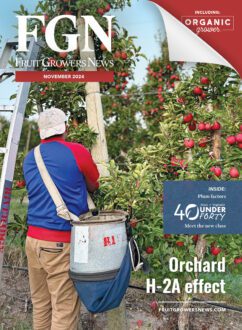Jan 3, 2011Chinese fresh apples step closer to U.S. market
Chinese fresh apples are a step closer to the U.S. market, but it might be years before they’re allowed within our borders – if they’re allowed at all.
In November, USDA’s Animal and Plant Health Inspection Service (APHIS) shared a finalized pest list with Chinese officials, in response to a market access request from the Asian country. According to the U.S. Apple Association, sharing the list represents the first official step toward allowing Chinese fresh apples into the United States – a move USApple opposes.
But according to Alyn G. Kiel, public affairs specialist for APHIS, sharing the pest list does not necessarily mean APHIS will allow the importation of fresh apples from China. It’s the beginning of a multi-year process, and no timeline has been set for a final decision.
Allowing Chinese fresh apples into the U.S. marketplace could have a huge impact on the U.S. industry. China produces about half the world’s apples and its production has increased 40 percent in the past decade. It has the capacity to bring a large amount of apples into the U.S. market at prices below the U.S. cost of production. When Chinese imports of apple juice concentrate were allowed in the 1990s, it significantly diminished the market for U.S. juice apples, according to USApple.
Pests are another concern. Under U.S. law, foreign apples must be free of damaging pests and diseases or have an acceptable mitigation plan before their import is allowed. The pest list APHIS shared with Chinese officials included 67 pests “of concern,” meaning they’re prevalent in China but aren’t yet in the United States – but could be brought in with Chinese apple imports. China does not have a reliable track record when it comes to preventing the export of exotic pests and diseases. Devastating insects like the Asian Longhorned Beetle, the Emerald Ash Borer and Brown Marmorated Stink Bug all are native to China, according to USApple.
For those reasons, USApple opposes the importation of Chinese fresh apples.
But China’s been pushing hard for its fresh apples to crack the U.S. marketplace, and might have filed a complaint with the World Trade Organization if the United States didn’t act, said Nancy Foster, president of USApple.
There’s another factor to weigh. Washington state growers are forecasting an additional 15 million bushels of apples in the next few years, a result of greater plantings. All those extra apples have to go somewhere, and Washington growers are looking at China as a potential market.
Currently, only U.S. Red and Golden Delicious apples are allowed in China. If Washington growers seek to expand that access to other varieties, Chinese officials could insist on reciprocal access to the United States, according to Denise Donohue, executive director of the Michigan Apple Committee.
– Matt Milkovich














